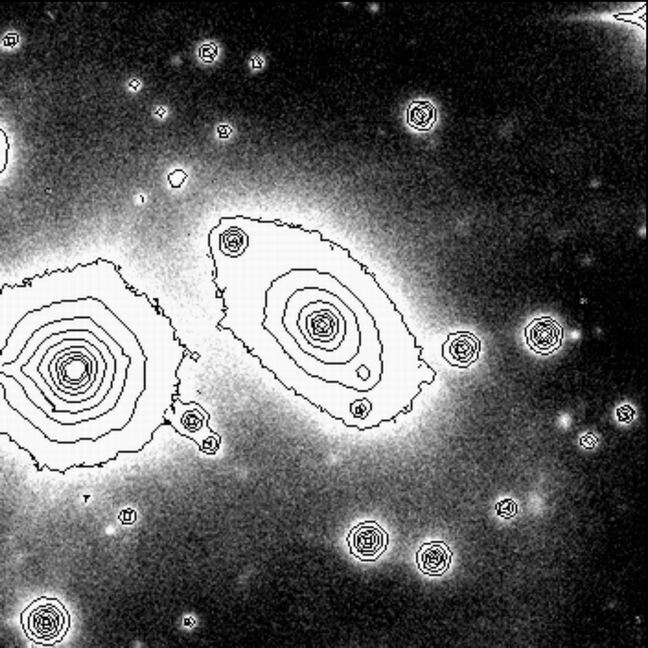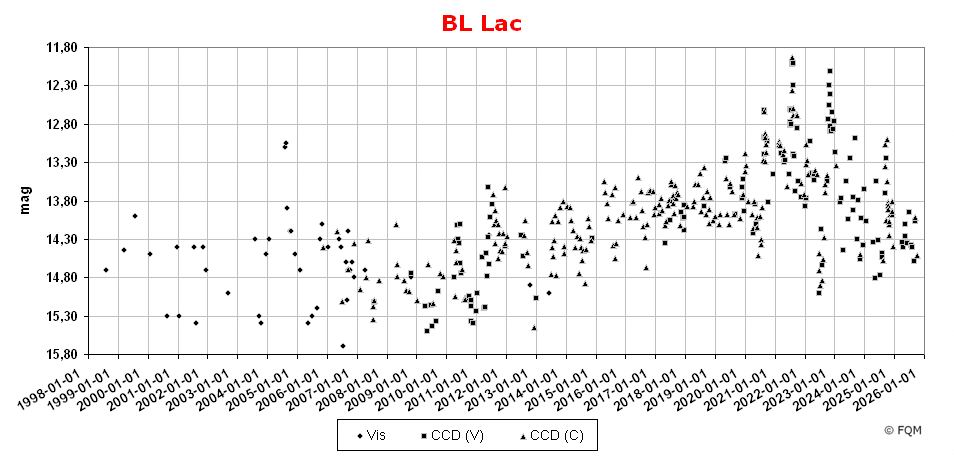
| Frankfurt Quasar Monitoring |
| BL Lac |
| Cross-Identifications | 2200+420, VRO 42.22.01, PKS 2200+420, B3 2200+420 S4 2200+42, TXS 2200+420, 87GB 2202+4202, OY+401 IRAS F22006+4202, 2MASS J22024329+4216400, DA 571 QSO B2200+420, XSS J22023+4226, RX J2202.7+4216 3EG J2202+4217, 1ES 2200+420, 0FGL J2202.4+4217 |
| Equat. coordinates | RA 22 02 43.3 DE +42 16 39 (J2000) |
| Constellation | Lacerta |
| Type | BL Lac |
| Redshift | z=0.069 |
| Distance (2) (3) | 274 Mpc |
| Total mag range (mv) (4) | 10.5 - 17.28 |
| Catalog Magnitude (1) | 14.72 |
| Absolute Magnitude (1) | -22.4 MB |
| Light Travel-Time (2) | 0.864 × 109 yrs |

Comparison stars
| star | B | V | Rc | Ic |
| 1 | 16.140
(0.108) |
15.232
(0.023) |
14.715
(0.011) |
14.276 (0.011) |
| 6 | 16.898
(0.063) |
16.120
(0.016) |
15.661
(0.013) |
15.206
(0.013) |
| 12 | 14.637 (0.028) | 12.938
(0.013) |
11.956 (0.018) | 11.083 (0.001) |
| 13 |
15.927
(0.020) |
13.897
(0.006) |
12.726
(0.002) |
---- |
| 16 | 15.719
(0.019) |
14.452
(0.004) |
13.686
(0.015) |
13.019
(0.009) |
| 17 | 16.387
(0.023) |
15.551
(0.009) |
15.051
(0.010) |
14.560
(0.011) |
| 19 | 16.979
(0.073) |
15.966
(0.014) |
15.342
(0.017) |
14.801
(0.010) |
| 20 | 13.991
(0.007) |
13.406 (0.010) | 13.013
(0.015) |
12.649
(0.013) |
| 21 | 15.185
(0.013) |
14.280
(0.008) |
13.753
(0.014) |
13.313
(0.015) |
| 25 | 14.353 (0.037) | 13.298 (0.004) | 12.688 (0.006) | 12.158 (0.018) |
| 27 | 17.112
(0.116) |
15.771
(0.059) |
15.059
(0.015) |
14.386
(0.034) |
| 31 | 17.734
(0.087) |
16.306
(0.028) |
15.668
(0.032) |
14.906
(0.043) |
 Credit: DSS2R
(ESO) / Size 2´× 2´
This
image shows BL Lac as an elong-ated object (phot. diam. 14"×11") |
 Credit: Nilsson et
al. (2003) / Size 61.8" × 61.8"
R-band
image by the Nordic Optical Telescope (image
inverted) |

| BL
Lacertae (BL Lac for short) is one of the most interesting and best
studied AGN. It is located in southern Lacerta, close to the
constellation
Cygnus. This object was discovered in 1929 by Kuno Hoffmeister at the Sonneberg Observatory, who
first
catalogued this object as a variable star with the designation 363.1929
Lac (later changed to BL Lac). In 1968, this object was identified as the
optical counterpart of the radio
source VRO 42.22.01, which had been discovered in 1965. The formerly
variable star became an
extragalactic object since a redshift was determined in 1974. BL
Lac lies at the centre of a giant
elliptical galaxy (see above) and
shows emissions from radio to gamma wavelengths. A jet with complex
structure was
detected in the radio, emerging from a central supermassive black hole,
which has an estimated mass of about 200 million solar masses. BL Lac is the prototype namesake of a whole class of AGN, the BL Lacertae objects, or blazars. The spectrum of this class of objects shows a continuum with (nearly) no emission lines, combined with strong flux variations at all wavelengths and a high degree of optical polarization. This strange behaviour is the result of the relativistic jet which is directed very nearly towards the observer. BL Lac is a violently variable object with a total range of nearly 7 magnitudes in the optical - one of the largest known (10.5 - 17.3 m). In general, BL Lac ranges between 14 mag and 15 mag, so visual observers need at least an 8- to 10-inch telescope or larger to glimpse this stellar object. At maximum brightness, BL Lac is visible even with a 4-inch telescope! During strong outbursts in 8-2004, 8-2020, 7/8-2021 and 10/11-2022, BL Lac reached mag 13.0 to mag 12.0 (see light curve). The 2´× 2´section from POSS (see above) shows the host galaxy of BL Lac as a slightly extended diffuse object (apparent diameter 14"×11"). This non-stellar optical appearance can only be recognized visually with large aperture telescopes at high powers. CCD observers, as well as visual observers, shall use the comparison stars given above. Other photometric sequences were published by Bertaud et al. (1969), McGimsey et al. (1977), Smith et al. (1985), Fiorucci et al. (1996) and Doroshenko et al. (2005) - which underlines the high astrophysical significance for this AGN prototype. ____________
BL Lac is located in southern Lacerta, 5.1° WSW of star 6 Lac and 5.2° NW of star 1 Lac. The position of BL Lac lies in the outskirts of the Milky Way. So there is plenty of interesting deep sky objects nearby. Some 11° to the west in Cygnus observers find NGC 7000, the famous "North America nebula". There are also some open clusters worth visiting: NGC 7209 (7.7 m) only 4° north, NGC 7243 (6.5 m) some 8° north, and finally IC 5146 (7.2 m) about 5.3° NNE. Open cluster IC 5146 resides in the "Cocoon nebula", the illuminated end of the large dark cloud Barnard 168 (B186), also known as the "Cigar". B186 is a very nice target for binoculars under dark skies. Last, but not least, two planetary nebulae shall not be missed. In Lacerta, some 9.4° N of BL Lac, observers may visit IC 5217, a tiny 11.3-mag planetary with a very bluish colour. The same blue colour gave the name to another famous planetary some 15° E in Andromeda: NGC 7662, the "Blue Snowball". |
| Bertaud, C., Dumotier, B., Véron, P., et al.
1969, A&A, 3, 436; Etude photometrique et radioelectrique de BL
Lacertae. Craine, E.R.; A Handbook of Quasistellar and BL Lacertae Objects, Parchart Publishing House, Tuscon 1977. DuPuy, D., Schmitt, J. 1969, ApJ, 156L, 135; Optical Observations of BL Lac = VRO 42.22.01. Fan, J.H, Lin, R.G. 1999, ApJS, 121, 131; Infrared Variation of Radio-selected BL Lacertae Objects. Fiorucci, M., Tosti, G. 1996, A&AS, 116, 403; VRI photometry of stars in the fields of 12 BL Lacertae objects. Gonzàlez-Pérez, J.N., et al. 2001, AJ, 122, 2055; Optical and Near-Infrared Calibration of AGN field stars: An All-Sky Network of faint stars calibrated on the Landolt System. Hansen, T. 1991, Deep Sky Magazine 34, 32; The "Deepest" Deep Sky Objects. Harrington, P. 1994, Astronomy 6, 56; Tracking down a Quasar. Hoffmeister, K. 1929, Astronomische Nachrichten, 236, 233; 354 neue Veränderliche. Karge, S.; Helle Quasare für 8- bis 10-Zoll Teleskope. Ein Beobachtungsführer zur visuellen Beobachtung von Quasaren und BL Lacertae Objekten; Frankfurt 2005. Katajainen, S., Takalo, L.O., et al. 2000, A&AS, 143, 357; Tuorla quasar monitoring. I. Observations of 1995-1997. Kinman, T.D. 1976, ApJ, 205, 1; Photoelectric Magnitudes and Polarization Data for possible BL Lacertae Objects. Lloyd, C. 1984, MNRAS, 209, 697; Optical monitoring of radio sources. Lü, P.K. 1977, AJ, 82, 10, 773; Optical monitoring of quasistellar objects. II. Three-color photographic photometry of BL Lac. MacLeod, J.M., Andrew, B.H. 1968, ApL, 1, 243; The Radio Source VRO 42.22.01. Marscher, A.P., et al. 2008, Nature, 453, 966; The inner jet of an active galactic nucleus as revealed by a radio-to-γ-ray outburst. McGimsey, B.Q., Miller, H.R. 1977, AJ, 82, 7; Photoelectric comparison sequences in the fields of optically active extragalactic objects. Miller, J.S., French, H.B., Hawley, S.A. 1978, ApJ, 219L, 85, The spectrum and magnitude of the galaxy associated with BL Lacertae. Nakamoto, D. 2018, Sky & Telescope 9-2018; The Enigma that is BL Lacertae. Nilsson, K., Pursimo, T., et al. 2003, A&A, 400, 95; R-band imaging of the host galaxies of RGB BL Lacertae objects. Oke, J.B., Gunn, J.E. 1974, ApJ, 189, L5; The Distance of BL Lacertae. Pollock, J.T., Pica, A.J., et al. 1979, AJ, 84, 11; Long-term optical variations of 20 violently variable extragalactic radio sources. Puschell, J.J., Stein, W.A. 1980, ApJ, 237, 331; Observations of strongly polarized extragalactic sources. Schmitt, J.L. 1968, Nature, 218, 663; BL Lac identified as a Radio Source. Selmes, R., Tritton, K., Wordsworth, R. 1975, MNRAS, 170, 15; Optical monitoring of radio sources - IV. Results up to 1973 April. Sillanpää, A., Haarala, S., et al. 1988, A&AS, 72, 347; Optical monitoring of quasars and BL Lac objects. Smith, P.S., Balonek, T.J., et al. 1985, AJ, 90, 1184; UBVRI Field Comparison Stars for Selected Active Quasars and BL Lacertae Objects. Steinicke, W.; Katalog heller Quasare und BL Lacertae Objekte; Umkirch 1998. Steinicke, W.; Beobachtungsliste für helle Quasare; Umkirch 1999. Steinicke, W.; Extragalactic Objects discovered as variable stars; Umkirch 2000. Stickel, M., Fried, J.W., Kühr, H. 1989, A&AS, 80, 103; Optical spectroscopy of 1 Jy BL Lacertae objects and flat spectrum radio sources. Strittmatter, P.A., Serkowski, K., et al. 1972, ApJ, 175, L7; Compact Extragalactic Nonthermal Sources. Stull, M.A. 1973, S&T, vol. 45 (4), 224; Two Puzzling Objects: OJ 287 and BL Lacertae. Veit, K., Wenzel, K. 1997, Interstellarum 12, 9; BL-Lacertae im Maximum. Vereinigung der Sternfreunde, FG "Visuelle Deep-Sky-Beobachtung"; Praxishandbuch Deep Sky; Kosmos, Stuttgart 2004. Vermeulen, R.C., Ogle, P.M., et al. 1995, ApJ, 452, L5; When is BL Lac not a BL Lac? Véron-Cetty, M.-P., Véron, P. 2001, A&A 374, 92; A Catalogue of Quasars and Active Nuclei: 10th edition. Véron-Cetty, M.-P., Véron, P. 2003, A&A 412, 399; A Catalogue of Quasars and Active Nuclei: 11th edition. Véron-Cetty, M.-P., Véron, P. 2006, A&A 455, 776; A Catalogue of Quasars and Active Nuclei: 12th edition. Véron-Cetty, M.-P., Véron, P. 2010, A&A 518, 10; A Catalogue of Quasars and Active Nuclei: 13th edition. Webb, J.R., Smith, A.G., et al. 1988, AJ, 95, 374; Optical Observations of 22 violently variable extragalactic sources: 1968-1986. Wenzel, K. 1997, Interstellarum, 10, 24; Quasare - Objekte für den beobachtenden Amateur. Wenzel, K. 1999, Interstellarum, 15, 36; Veränderlich und Extragalaktisch. Fehlidentifikationen zwischen variablen Sternen und Aktiven Galaxien. Wenzel, K. 2005, Interstellarum, 38, 54; BL Lacertae-Objekte. Eine visuelle Langzeit-Überwachung. Wenzel, K., Düskau, W. 2003, SuW 2/03, 60; BL-Lacertae-Objekte - Eine Herausforderung für den Amateur. Xie, G.Z., Li, K.H., et al. 1990, A&A, 229, 329; Search for short variability time-scales of BL Lacertae objects. Xie, G.Z., Li, K.H., et al. 1992, ApJS, 80, 683; CCD Photometry of 14 BL Lacertae objects and theoretical model. |
| Links: Landessternwarte Heidelberg Chara/PEGA Hamburg Quasar Monitoring Gary Poyner (light curve) BAAVSS (light curve) AAVSO (vsots) |
| home |